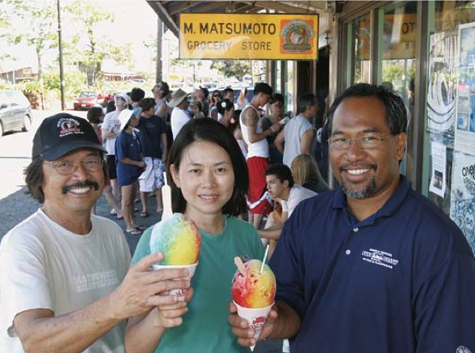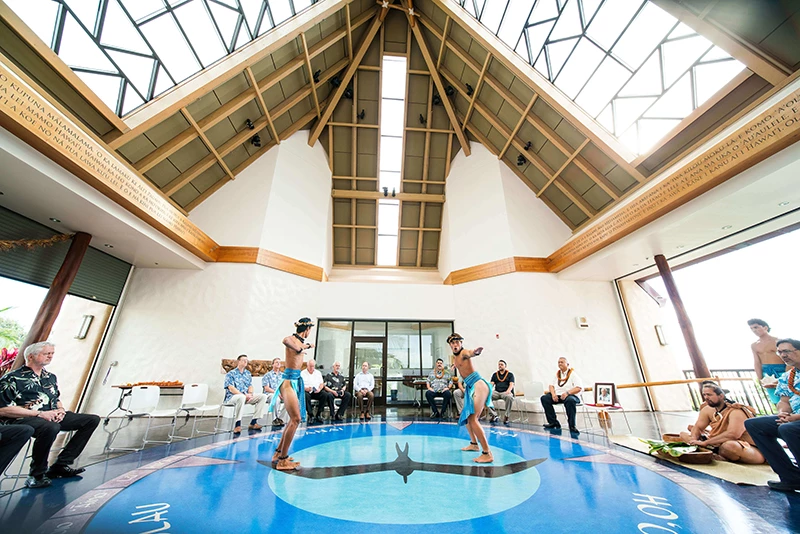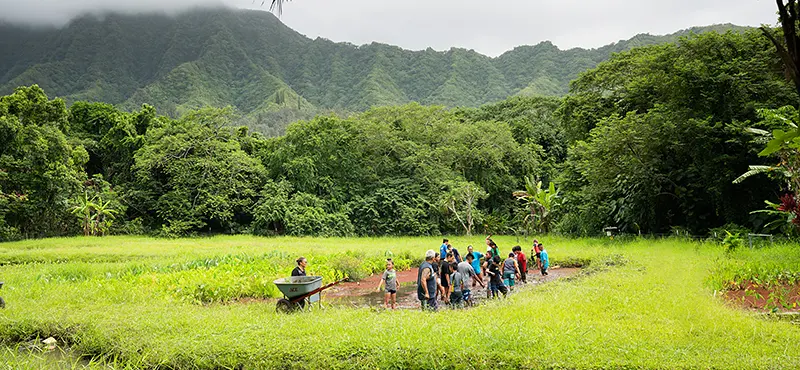“North Shore Plan” Completed
September 30, 2010
Contributed by
Thomas Yoshida

Stan and Noriko Matsumoto, owners of Matsumoto Shave Ice, and Kamehameha Schools asset manager Kalani Fronda '88 raise a shave ice toast to the completion of Kamehameha's North Shore Plan. In September, the Hawai'i Chapter of the American Planning Association honored Kamehameha's efforts with its 2008 Outstanding Planning Award. (Michael Young photo)
It's a sweet island tradition. In fact, no trip to O'ahu's North Shore is complete without a stop for some world renowned Matsumoto's shave ice.
On a typical Hawaiian summer day, nearly 1,200 tourists and residents alike visit the North Shore landmark for a taste of the syrupy treat. For the past 57 years, the M. Matsumoto Store has been almost as popular an attraction as the area's big waves.
However, the historic Matsumoto and adjacent Aoki shave ice stores are located in aging buildings on Kamehameha Schools lands with poor pedestrian support.
At Matsumoto's in particular, people often wait in line in front of the store which has almost no setback, creating a less than ideal situation for pedestrians and motorists.
 But help is on the way for these iconic businesses.
But help is on the way for these iconic businesses.
Kamehameha's recently completed "North Shore Plan," conceptually approved by trustees in April 2008, calls for a reinvigoration of the organization's commercial assets in the North Shore area. Other key segments of the plan address agricultural, educational, residential, sustainability and alternative energy initiatives.
As one of seven catalyst projects of the North Shore Plan, the "Matsumoto Redevelopment" would renovate the historic storefronts and add a small amount of additional retail space, parking and sidewalks.
"The near term focus for Kamehameha's commercial assets in Hale'iwa is to improve the areas that are dilapidated and other areas where a few of the buildings are falling apart," said Kamehameha Schools asset manager Kalani Fronda '88.
"The area where Matsumoto and Aoki in particular are located requires our attention first.
Improvements here will demonstrate our willingness to be an active member of the community by recognizing the icons of the North Shore and investing our resources to feature them."
With more than 365,000 acres of Hawai'i real estate, Kamehameha Schools is the largest private landowner in Hawai'i and uses funds generated from these lands to support its educational programs and services.
In its land stewardship throughout Hawai'i, Kamehameha focuses on the values of education, culture, environment and economics with a healthy community at the center of these inter-related values.
These five values and the Kamehameha Schools Strategic Plan 2000-2015 provided the foundation on which the North Shore Plan was based. Kamehameha owns 26,200 acres of land on the North Shore.
The upper 15,000 acres are conservation lands in a mountainous area that is also a significant watershed. Below the conservation lands are 9,000 acres of agricultural lands (5,500 acres are usable) — fed by surface waters from the ma uka area, as well as groundwater — that produce crops with about 2,500 acres currently in diversified agriculture.
The 2,000 acres of land along Kamehameha Highway includes some agricultural land but is the region's primary residential and commercial area. Hale'iwa Town, the area's commercial core, serves more than 10,000 residents and 2.5 million annual visitors to the North Shore.
How best to strengthen Kamehameha Schools' assets on these lands over the next roughly 15 years — while keeping intact the area's "country" island lifestyle — was the task at hand for Kamehameha planners.
Guidance on maintaining the character of the region was found in the existing North Shore Sustainable Communities Plan and the Waialua Town Master Plan put together by the City and County of Honolulu.

Area residents, kūpuna and business owners helped shape the North Shore Plan. From left, Kamehameha asset manager Kalani Fronda '88, Lavina Silva Agader '68, Jack Jenkins, Betty Ellis Jenkins '45, Stan and Noriko Matsumoto, Dorothy "Kanani" Mathias Awai '51, Kawika Au, Gladys Awai-Lennox, Colleen Leong. (Michael Young photo)
Recommendations suggested in the Hale'iwa Town Plan, developed by the North Shore Chamber of Commerce, were also key.
"It was important that we respect the previous planning efforts and didn't try to develop or establish something that was out- side of those parameters," Fronda said. "We've taken an active role in making sure that we continue to know the pulse of the community, know what is happening at the city level and respect what's already been said and done."
It could be argued that the finest aspect to the North Shore Plan was the process that led to its development. Starting in July 2006, Kamehameha planners held more than 30 meetings with area stakeholders including elected and government officials, business leaders, neighborhood board members, farmers, other landowners and area residents.
A youth forum involving Waialua High School students and 3,000 surveys mailed to North Shore households were also used to gather community input.
 "We traveled to all ends of the moku, meeting with whoever would allow us to meet with them." Fronda said. "We wanted to make sure there was an open and comprehensive process, so we invested a lot of time prior to starting the plans in getting to know the mana'o from the community.
"We traveled to all ends of the moku, meeting with whoever would allow us to meet with them." Fronda said. "We wanted to make sure there was an open and comprehensive process, so we invested a lot of time prior to starting the plans in getting to know the mana'o from the community.
"We didn't want to come out with a plan and get reaction later. People are very passionate about this area, and they all have different interpretations of what 'keeping the country country' means. This was about building relationships, identifying opportunities and together coming up with a sustainable vision." Following traditional
Hawaiian cultural values, area kūpuna were the first to be consulted in the gathering of mana'o.
"Because we are a Hawaiian institution, we wanted to be culturally and spiritually sound and carry out this effort in a pono way. So we began the process by first meeting, talking story and praying with kūpuna," Fronda said.
Aunty Betty Ellis Jenkins '45 is an esteemed retired educator credited with starting the Department of Education's kūpuna program. A Waialua resident, Jenkins said she attended nearly every community meeting involving the North Shore Plan.
Related Content:
 Fall 2008 issue of I Mua Magazine
Fall 2008 issue of I Mua Magazine










 But help is on the way for these iconic businesses.
But help is on the way for these iconic businesses.
 "We traveled to all ends of the moku, meeting with whoever would allow us to meet with them." Fronda said. "We wanted to make sure there was an open and comprehensive process, so we invested a lot of time prior to starting the plans in getting to know the mana'o from the community.
"We traveled to all ends of the moku, meeting with whoever would allow us to meet with them." Fronda said. "We wanted to make sure there was an open and comprehensive process, so we invested a lot of time prior to starting the plans in getting to know the mana'o from the community.

